Baby Proofing Your Home, Room by Room: 36 Areas to Address Around the House
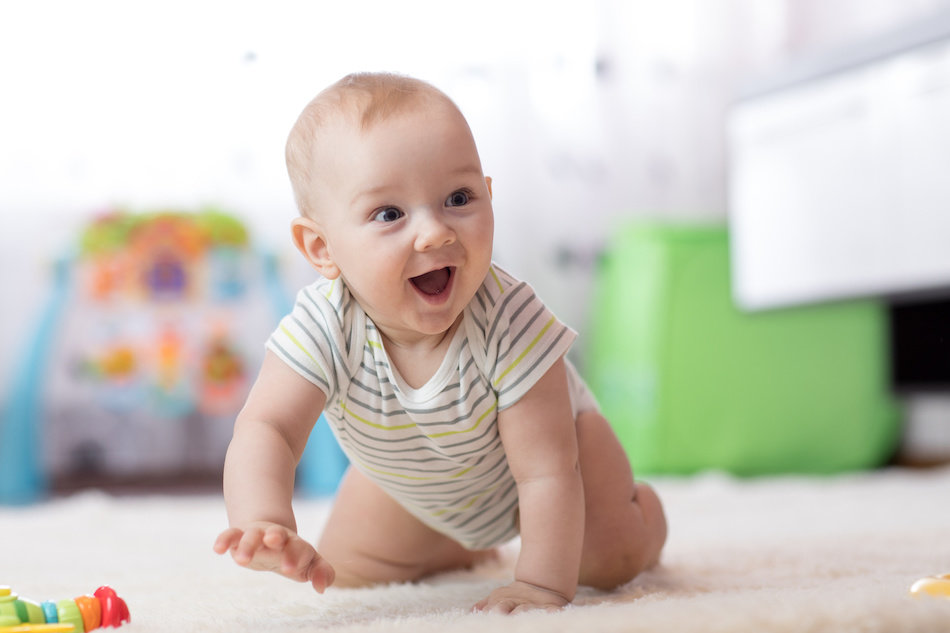 Baby proofing is a matter of making a home safe for your baby now and into the future as they grow. Babies begin their life at home relatively safe because their limited mobility. In early infancy, babies can barely see and have no ability to move around independently. They can't roll over, can't support the weight of their own head and don't have full control to unclench their own fingers! However, some may be surprised at how fast that all changes. By about 3 months old, babies can grab onto things and around 6 months old, many are able to sit up. As your baby changes, your house and surroundings must change as well. Babies and toddlers love to learn about and explore their world. They learn by picking things up, moving around, putting things in their mouth and by poking or touching things within their reach.
Baby proofing is a matter of making a home safe for your baby now and into the future as they grow. Babies begin their life at home relatively safe because their limited mobility. In early infancy, babies can barely see and have no ability to move around independently. They can't roll over, can't support the weight of their own head and don't have full control to unclench their own fingers! However, some may be surprised at how fast that all changes. By about 3 months old, babies can grab onto things and around 6 months old, many are able to sit up. As your baby changes, your house and surroundings must change as well. Babies and toddlers love to learn about and explore their world. They learn by picking things up, moving around, putting things in their mouth and by poking or touching things within their reach.
As babies turn into toddlers, they develop more physical ability, but remain unaware of the consequences of their actions. As a parent, it's up to you to protect your baby. While many parts and places in the home may seem innocuous enough, it's important to consider things from a non-adult perspective. Baby proofing makes your baby's environment safe to explore as they learn and grow. You can also do this with Jersey Shore rentals to help others stay safe as well! Consider the following when preparing a home for a new member of the family.
Table of Contents
- General Baby Proofing Tasks
- Doors and Door Knobs
- Electrical Outlets
- Window Blinds and Cords
- Stairs and Floor Vents
- Heavy Furniture and Decor
- Everyday Items
- Trash Cans
- Cleaners and Toxic Products
- Alarms
- Living and Play Areas
- Kitchen and Dining Room
- Bathrooms
- Baby's Room
- Laundry Room
- Garage
- Outside Areas and Backyard
- Safety First!
General Baby Proofing Tasks
Each room has its own unique hazards, but some hazards that can be found consistently throughout the home. Windows - for example - are found in multiple rooms and may lead to falls, bumps, or cuts. Some may also pose as a strangulation hazard, as the cords on blinds can easily become wrapped around a child's neck. These hazards are ubiquitous in modern residential architecture: nearly every room has windows and electrical outlets. Fortunately, there are many inexpensive and practical solutions for parents with small children.
Doors and Door Knobs
The problem: Children who are old enough walk or toddle can open doors and let themselves into rooms and even out of the house. And when doors close, they can get their fingers caught in the hinges, or smashed between the door and the frame.
Solutions:
- Doorstops are a product often made of foam or rubber, that attaches to the door and prevents it from closing completely or too quickly.
- Door latches prevent toddlers from opening doors they should not open.
- Door knob/lever locks can be attached to door knobs or levers to prevent them from operating the lever or knob.
Door latches or locks are especially important in homes where the door is opened and closed by a lever instead of a handle. Door levers are very easy for young children to operate. Door knobs are more difficult and require dexterity that many toddlers do not have yet.
Electrical Outlets
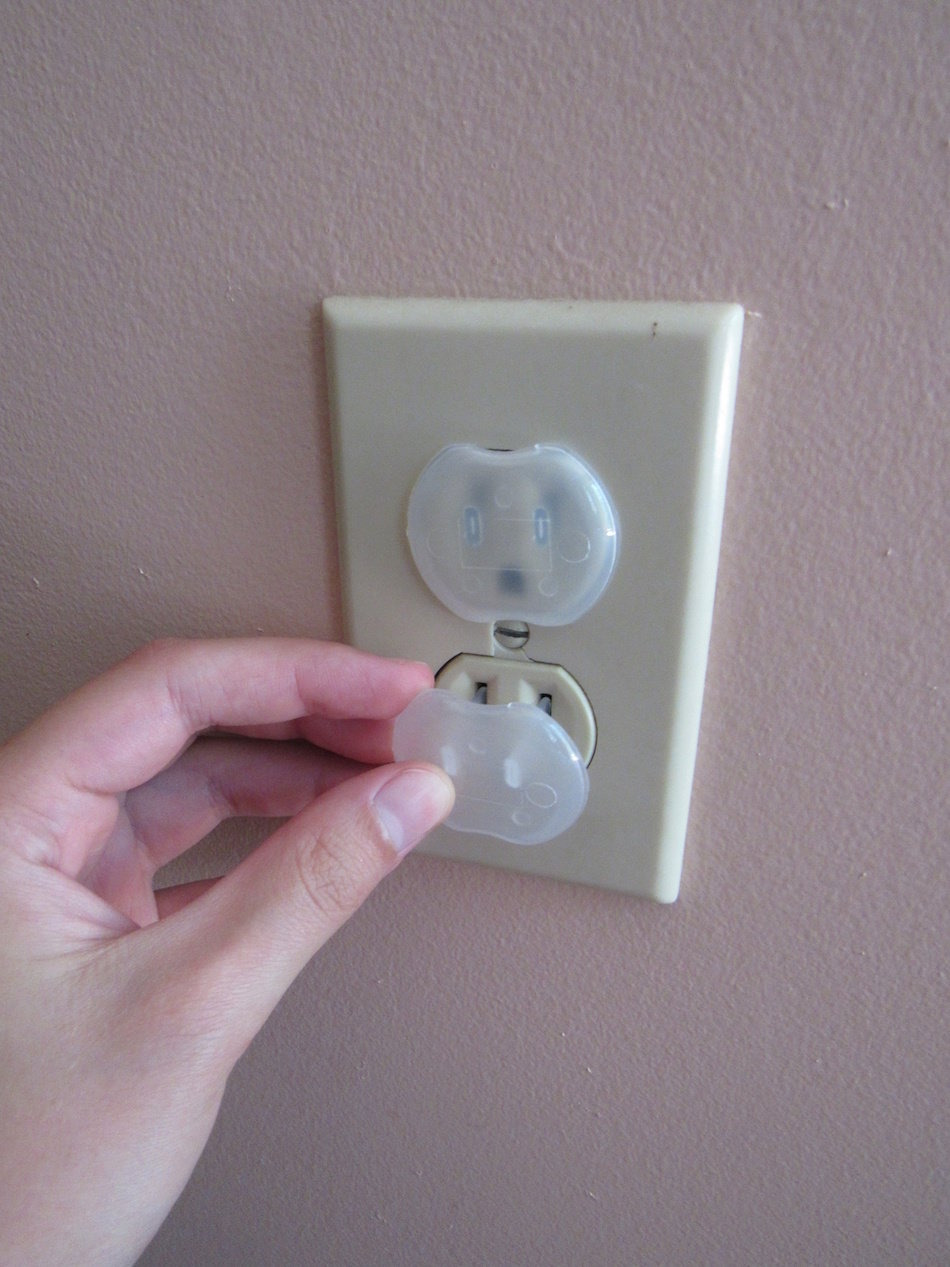
The problem: Many children love to stick their fingers into holes and, for that reason, they may find electrical outlets very enticing. They also love to stick other things like sticks, toys, or bits of debris they find on the floor into holes. Electrical outlets present a very real threat to children, who can easily be electrocuted as they explore.
Solutions:
Outlet covers range in price and sophistication. Parents have many options based on their needs and level of convenience.
- Plastic outlet plugs are inexpensive and can be safely inserted into any electrical outlet.
- Sliding outlet covers slide into and out of place, to allow adults access to outlets as needed.
- Power strip covers give adults the ability to cover up their power strips while it's in use.
Window Blinds and Cords
The problem: The Journal of American Medical Association (JAMA) estimates that a child is strangled in window cord blinds every two weeks, and most of these children are three years old or younger. The solutions mentioned below vary in price, each having their own pros and cons. Parents should explore the options (including the advantages and disadvantages of each) before deciding which is right for them.
Solutions:
- Cut the ends of the cords, so they are no longer looped.
- Tie up the cords, so they cannot be reached from the floor.
- Cordless blinds are excellent, especially for homeowners who can afford all new window treatments.
- Blind cord windups allow homeowners to wind up their blind cords in a device that keeps the cord neatly out of reach.
Cutting the cords reduces the risk, but does not eliminate the possibility of strangulation. Tying up cords can be effective if the cords stay tied, but cords can get loose and begin to dangle. Using blind cord windups is typically more effective.
Stairs and Floor Vents
The problem: Stairs are an obvious hazard for children of all ages. Children who are too young to traverse the stairs must be kept away from stair cases. Older children who are just learning must be taught safe strategies for going up and down stairs independently.
Floor vents are also a problem because they can be sharp and metal. Very old floor vents also have bigger holes where children can throw down toys or even get their fingers caught.
Stair solutions:
- Install baby gates to prevent toddlers from accessing stair cases.
- Teach older toddlers how to scoot down stairs on their bottoms, to prevent them from falling when moving up and down stairs independently.
- Have talks about stair safety with children who are old enough to understand that stairs must be walked safely and isn't a place to play.
- Practice going up and down stairs while holding the railing.
- Model appropriate stair use, by taking stairs one at a time while holding the railing.
Vent solutions:
- Arrange pieces of furniture to block children from accessing these vents.
- Replace metal or old fashioned vents with plastic vents to prevent children from cutting themselves.
When moving furniture to block vents, be careful not to cover vents entirely. Covering floor vents can make rooms cold and may even prevent your furnace and air conditioner from working properly.
Heavy Furniture and Decor
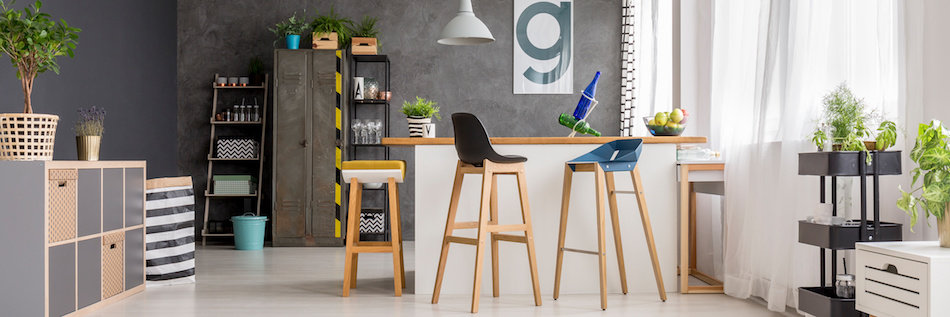
The problem: Children can easily try to climb and pull heavy furniture and large decor down on top of themselves. This problem goes beyond the commonly thought of dresser and TV stand and extends to decorative items such as sculptures, big mirrors and other things that aren't secured to the wall.
Solutions:
- Move large pieces to make them inaccessible.
- Secure large pieces, such as TV's, using straps or wall mounts
- Strap heavy or bulky items to the wall with earthquake or baby proofing straps.
While you're strapping things and moving them to inaccessible spaces, take the time to check your walls, baseboards, the condition of your windowsills and so on. Look for peeling paint, loose baseboards, peeling caulk and other maintenance problems that could cause accidents. Make small home improvements as you go, or start a list of home improvements to make when you're finished with the rest of your baby proofing.
Everyday Items
The problem: Many everyday items like clutter, pet food, litter box material, purses and bags are all interesting to young toddlers. Walking around your house, you may see a variety of hazards like stray scissors, toys for older children, puzzle pieces, pens, markers and little coins. Guests who visit may unknowingly bring hazardous items with them such as medications, hair pins and sewing needles.
Solutions:
- Declutter before your child is able to walk.
- Install modular organizational systems that keep clutter off the ground and make organization easy.
- Install hooks where your purse or bags can get hung, and children cannot access the contents.
- Protect the litter box with a door latch that allows the cat to enter the room with the litter box and pet food, but which keeps your child out.
- Install a smart dog water and food dish that will enable your dog to access food and water, while keeping your little one out.
Trash Cans
The problem: Trash cans are a safety hazard and a mess hazard! They're also a source of fascination for toddlers who see their parents putting things in there all day long. Think about all the things you throw away or recycle in an average day, like used cans, toothpicks, broken items and food - then imagine your child going through all that. It's also worth noting that children will throw things away that should not be thrown away, as they try to mimic their parents.
Solutions:
- Safety latches keep children out of trash cans until they are old enough to understand what can and cannot be put in the trash.
- Move the can to an area under the sink or in a pantry, where your child cannot access it.
- Place the trash in an area that's behind a baby gate to prevent your child from accessing it.
Cleaners and Toxic Products
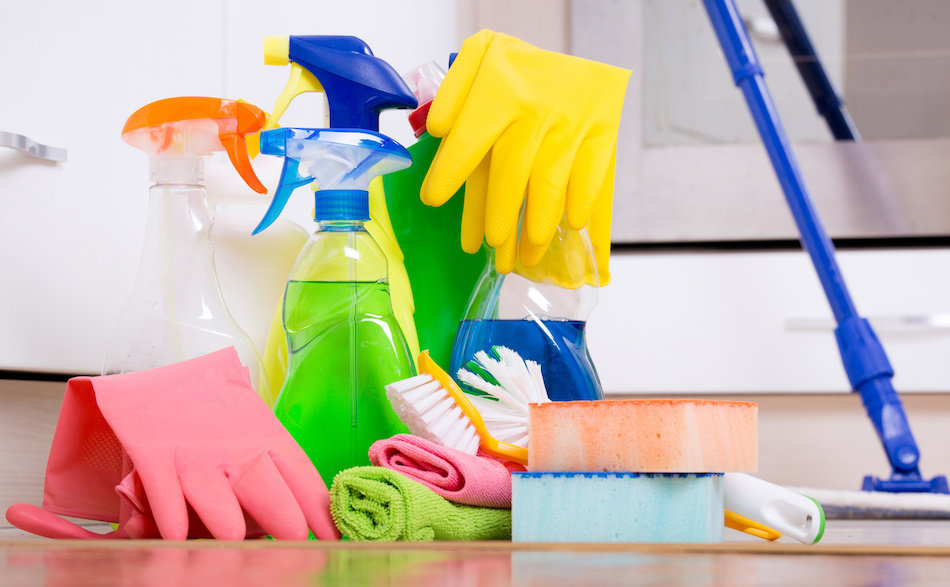
The problem: Poisons can be found throughout the house in the form of cleaning products, medicines and other household chemicals. The most common poisons that affect children include cosmetics, houseplants, antihistamines, vitamins, pesticides and other cleaning and dusting products. Poisons can be found in the kitchen, bathroom, bedrooms, basement, garage and nearly anywhere else that might be decorated with a houseplant. If you're cleaning your Belmar home for sale, you'll want to keep all of this out of reach.
Solutions:
- Keep poisons in high cabinets where they cannot be reached.
- Research common household poisons, so you know which ones are present in your house.
- Install baby latches on all cabinets that are within reach for your toddler.
- Educate guests to ensure they keep their medicines out of reach.
- Replace soaps and detergents with natural non-toxic soaps.
Move houseplants to upper shelves, or take plants known to be toxic to your workplace.
Alarms
The problem: Carbon monoxide detectors and smoke detectors alert parents and homeowners to fires and the presence of carbon monoxide. Unfortunately, these alarms only work if they're in working order and have fresh batteries. Sometimes parents disable alarms without heeding them because they believe the alarms are going off without reason. Sometimes this happens with disastrous results, never ignore a sounding alarm.
Solutions:
- Test alarms monthly.
- Replace batteries once or twice per year, according to manufacturer instructions.
- Replace the entire detector by the expiration date.
- Do not ignore alarms; exit the house and have it inspected before going back inside.
Carbon monoxide is a problem that occurs because of poor combustion. Any appliance, product or part of the house that requires combustion to function (from the car to the heater, gas dryer and fireplace) is a possible source of carbon monoxide. Have your appliances routinely checked by a professional, and fix any maintenance problems as soon as they occur.
Living and Play Areas
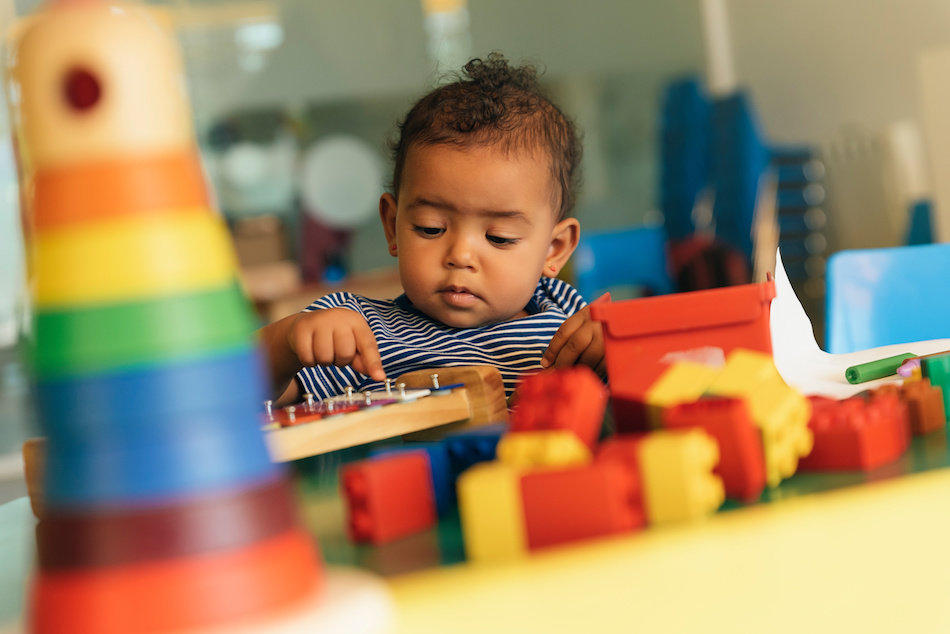
Your baby or toddler will no doubt spend a lot of time in the living and play areas of your home, like the living room, toy room, family room or nursery. These parts of the house must be thoroughly baby proofed.
After baby proofing is finished, your living room might look and function a little differently for your child's first few years. Safety comes first. Pick and choose the most necessary baby proofing steps depending on your child's behavior and habits. Know your child and know what they're likely to get into.
Furniture
The problem: Many living room pieces have sharp corners that can easily become a hazard for a toddler just learning to walk. While other pieces of furniture can be climbed on and tripped over, causing falls and sometimes serious accidents.
Solutions:
- Arrange furniture strategically to prevent your child from accessing dangerous pieces.
- Install corner covers to soften the hard corners of coffee and side tables.
- Use soft rugs to create a cushion beneath any furniture your toddler likes to climb upon.
- Teach your child how to use furniture appropriately and safely.
- Remove furniture that is not safe and cannot be made safe through baby proofing.
- Use baby gates to block your child from parts of the home that are full of hazards and are not essential.
Baby proofing is also a good opportunity to redecorate. Get rid of any rickety furniture that isn't worth keeping. When your child is older, you can replace these pieces with something sturdier.
TV and Electronics
The problem: Kids love flashing lights and buttons. They're attracted to anything that is bright, shiny or even a little bit noisy. The risk of electrical shock, cords, sharp edges and places where fingers could get stuck are just a few of the risks that electronics could pose. Not to mention parents who do not protect their technology from their children could find themselves replacing handheld devices worth thousands of dollars.
Solutions:
- Keep remote controls out of reach.
- Strap the television to the TV stand or fully mount on the wall.
- Store computers and other gadgets on desks too high to reach.
- Bundle cords neatly, use surge protector covers and keep out of reach
- Educate your little one from early on, teach them what's off limits.
Many parents have stories about children who have accidentally ordered expensive products or made expensive problems by playing with a smartphone. Never give your toddler a working smartphone that is connected your accounts and networked household devices. Remember that even just pushing the buttons for your passcode over and over again could lock you out of the device.
It's easy to use technology as a quick babysitter, but it's very important to limit unsupervised "screen time" and to watch your child when they're close to the entertainment or computer areas.
Fireplaces and Hearths
The problem: Fireplaces and hearths are dangerous for a variety of reasons. Hearths that rise up from the floor can have very sharp corners, and children who fall onto the hearth can hit their head easily. And once more mobile, toddlers can burn themselves if they can reach the fire, but simply keeping the glass doors shut isn't good enough. The glass itself can heat up to hundreds of degrees when a fire is burning.
Solutions:
- Crib or coffee table bumpers may be used to cover sharp hearth corners.
- A fireplace gate prevents your child from accessing the fireplace and hearth altogether.
Some parents stop using their fireplace in the years when their toddlers are very young. If you choose not to use your fireplace, fill it with unlit candles, firewood or creative seasonal decorations. As soon as your child is old enough, start teaching them about fire safety.
Baby Gates
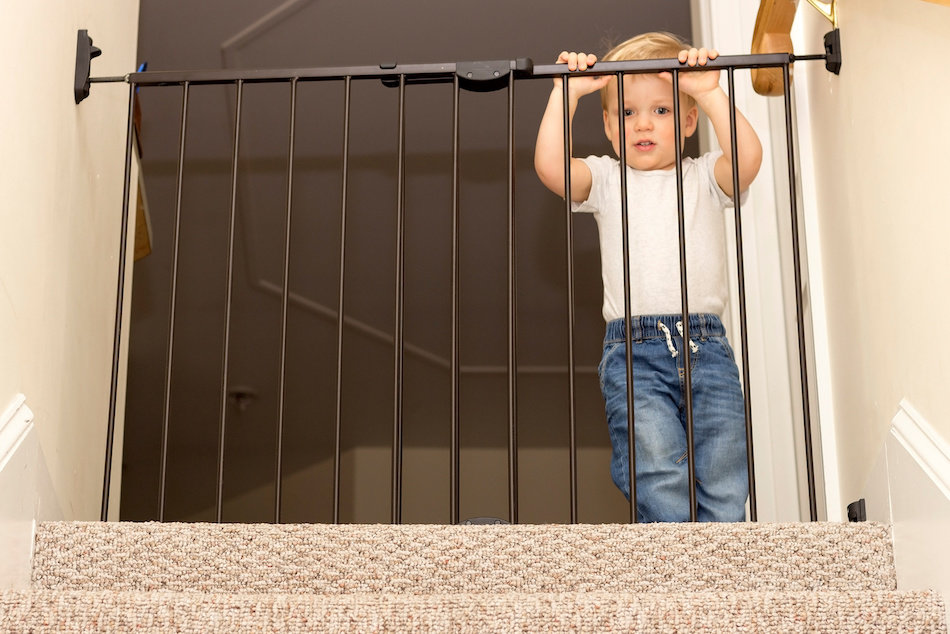
Baby gates aren't a one-size fits all product. They now come in all shapes and sizes. You can choose the right baby gate based on the layout of your home as well as the needs and abilities of your child. Baby gates can be used to block the stairs, create an off-limit area, cut off a whole room or box your baby into a safe space.
Tension Mount Gates
Tension mount gates require no tools to assemble. They use tension to stay mounted to the wall, and when they're not needed, they're easy to remove. Tension mount gates are the classic baby gate. They come in standard doorway sizes and in extra-wide sizes for hallways and large doorways.
Hardware Mounted Gates
Hardware mounted gates attach to the wall using screws. They're perfect when you need a little extra strength and durability, like if you're preventing a toddler from falling down the stairs.
Self Closing Or Not?
Some gates are spring operated and will close on their own, others must be closed deliberately. Spring operated gates are especially helpful in locations where accidentally leaving the gate open could be disastrous.
Multi-Paneled Gate with Moveable Hinges
Use your multi-paneled hinged baby gate to create an enclosed play area, or open it up and stretch it across an extra wide entrance. These flexible gates can be used indoors and out.
Toys and Toy Box
The problem: Toys and toy boxes are critical to have around the house, but not all products are 100% safe, especially when left with an unattended baby or toddler. Toys for older children can have little parts that they can easily swallow, while some toy boxes can smash little fingers. Old toys can harbor germs, not be safe for today's standards or just plain get in the way.
Solutions:
- Check the recommended age range for toys that are given to your child before they're allowed to play with them.
- Put away toys for older children until your child is of the appropriate age.
- Get rid of old toys when they're no longer being used, or wash them and put them away for future siblings.
- Research toys before choosing products for your child; toys should be of sturdy construction, and made with lead-free paint.
Classic wooden toy boxes are attractive, but they can hurt your child's fingers if they slam shut. Choose a toy box with a lightweight, removable lid, especially for those who enjoy climbing inside.
Kitchen and Dining Room
A high chair is safest when you want to keep your toddler close to you in the kitchen. Once your child starts to walk, they'll want to follow you around everywhere on foot. The kitchen is a room full of hard surfaces and dangers, from foods and kitchen tools like toasters, colorful portable blenders like Nutribullet, to hot grease and open flames.
There are many ways to keep your child safe even while they're under foot in the kitchen. In this section, we'll discuss some tools and methods you can use to upgrade your kitchen and ensure that your little one is protected.
Cabinets
Cabinets can contain all kinds of hazards, including the cleaning products and other toxic products mentioned above. Breakable items like glass vases and jars present their own kind of hazard because they're breakable, and little shards can make big problems. Keep these cabinets latched with one of the many types of baby proof cabinet locks on the market.
Pro Tip:
Many kids will ignore the majority of the cabinets if they're allowed to play with objects in at least one cabinet or drawer. Put some toys, plastic storage containers, measuring cups and other harmless objects into one cabinet, and make it clear to your little one that they're only allowed to use that cabinet.
Rotate objects in the cabinet if your child starts to get tired of what's always in there. Playing in their cabinet will keep them busy and you'll be able to keep an eye on them while you cook. Keep the cabinet out of the general flow of traffic, and away from the range of grease splatter around the stove.
Refrigerator and Pantry
The problem: Children see where their snacks come from, so it doesn't take long before they're ready to explore those parts of the house themselves. Toddlers who are able to access the refrigerator and pantry can make a mess for you to clean and create need for yet another shopping trip. Worst-case scenario, your child might climb into a space where they can't get out, or ingest something dangerous.
Solutions:
Restricting access to these areas may be the simplest solution, since this cuts off access to everything dangerous in the kitchen. However, if restricting access to the kitchen is too untenable, install latches or door knob coverings on the pantry and refrigerator door.
Baby proofing companies make latches specifically for restricting access to the refrigerator, however many multi-purpose straps will also do the trick. Style of refrigerator will affect the type of baby proofing device needed.
Oven and Stove
The problem: Children like knobs and buttons. They also like to play with anything they see their parents using frequently, so the oven and stove are an obvious source of fascination. A toddler who is able to reach the knobs could inadvertently turn on the oven or stove. Towels hung on oven door handles also give little ones the ability to open the oven, which could lead to a variety of serious hazards.
Parents who carry their babies in a wrap, carrier or on their hip while using the stove could potentially burn their baby inadvertently through hot food splatters or fire burns. Finally, pan handles that face out could be grabbed and pulled down onto a little one standing beneath.
Solutions:
- Oven and stove knob covers prevent your child from accidentally operating the appliance without your knowledge.
- Remove towels from the stove handle to prevent your child from pulling them down and opening the stove.
- Use the "self-cleaning" locking mechanism to lock the door between uses.
- Get in the habit of turning all pot and pan handles in toward the counter or stove.
- Do not carry your child and use the stove simultaneously.
- Baby proofing oven locks keep the oven door closed if a self-cleaning lock does not work.
When purchasing a baby proofing lock for your oven, check item specifications and consumer reviews to ensure that the lock you purchase is heat-resistant, since it will be near your stove.
It's very important to educate your child about the importance of stove and oven safety. One of the ways that you can emphasize the dangers of the oven is to make your toddler move to the other side of the room before you open the oven door. Explain to your child that the inside of the oven is very hot and even just touching the inside of the door could cause a burn. Never playing in the kitchen, being consistant and using a serious tone will help your child understand the seriousness of the situation.
Dishwasher
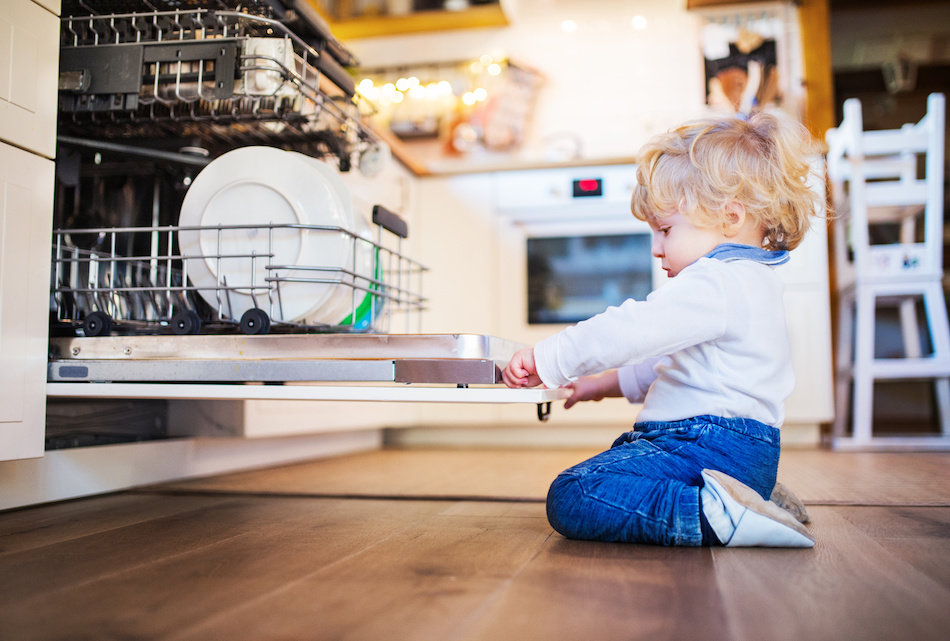
The problem: The dishwasher is another source of fascination because of the buttons, lights and noise that the dishwasher produces. Dishwashers tend to be self-locking, requiring a button or sliding handle to be pushed or used to open the dishwasher door.
Still, some are easier to open than others, and easy to open models will give toddlers access to dishes inside. Some toddlers may hurt themselves by climbing onto the rack, others may climb onto the door causing costly damage to the appliance. Finally, toddlers may accidentally turn on the dishwasher, which could lead to wasted water and inconvenience.
Solutions:
- Keep the door locked whenever possible.
- Install a multi-purpose baby proofing latch.
- Avoid using the dishwasher until your child is older.
- Educate your child about dishwasher safety and boundaries in the kitchen.
Some dishwasher models have a child-locking sequence. Pushing a combination of buttons on the dishwasher will activate the sequence. Instructions can be found in the owner's manual that came with the dishwasher, or look up the model online.
Dining Room Table and Chairs
The problem: Tablecloths and placemats are fun to grab and easy to pull down. Children who play around the table can easily pull dishes and even hot bowls onto the floor or onto themselves. Sharp corners on tables and chairs can lead to injuries, while food left on the floor under the table may find its way into your toddler's mouth.
Solutions:
- Stop using tablecloths and placemats for a while.
- Install bumpers on sharp edges.
- Switch chairs for a while (if they have too many sharp edges).
- Block access to the table with a baby gate.
Clean the floor under your table after every single meal. If a dish or glass is broken, clean under the table several times and clean over a wider area to catch pieces that may have landed many feet away from the site of the accident. Just because your Point Pleasant home's kitchen is beautiful, doesn't mean it can't present hazards to children.
Bathrooms
It's estimated that about 87 children die annually by drowning at home, and many of those drownings happen in the bathtub. Bathrooms are the source of many accidents in the home, including slips and falls, electrocution and poisoning.
Many bathrooms are as dangerous as the kitchen in terms of hard surfaces and hazards that children encounter there, but it's much harder to keep children out of the bathroom. Between bathing and using the toilet, children spend a lot of time in the bathroom. This makes baby proofing this area of your home even more important. Observation and careful planning makes it possible for you to keep your child safe while they use this room.
Toilets
The problem: Toilets are not made with young children in mind. The hole for the bowl is as wide as a child's body (and then some). Children who fall head-first into the toilet can drown, while the toilet lid can be heavy and capable of pinching your little one's fingers. Toilet paper is also attractive to children, who may stretch it around the room or even eat it.
Solutions:
No matter how many baby proofing devices you keep in your bathroom, you should always monitor your young child while they're using the toilet and in the bathtub. Being there to help your child the moment they run into trouble can prevent a tragedy like a drowning.
- Child-proof locks keep the toilet lid shut until you open it for your toddler.
- Toddler toilet seats fit over standard toilet seats and prevent your little one from falling in while using the toilet.
- Hide the toilet paper or place in an unreachable location.
If you do hide the toilet paper, put a sign up somewhere in the bathroom to indicate its location, this will help guests when they visit. While you're hiding the toilet paper, stash the toilet brush under your bathroom sink, or in an out-of-the-way location. This will prevent your little one from playing with it or putting it in their mouth.
Medications and Toiletries
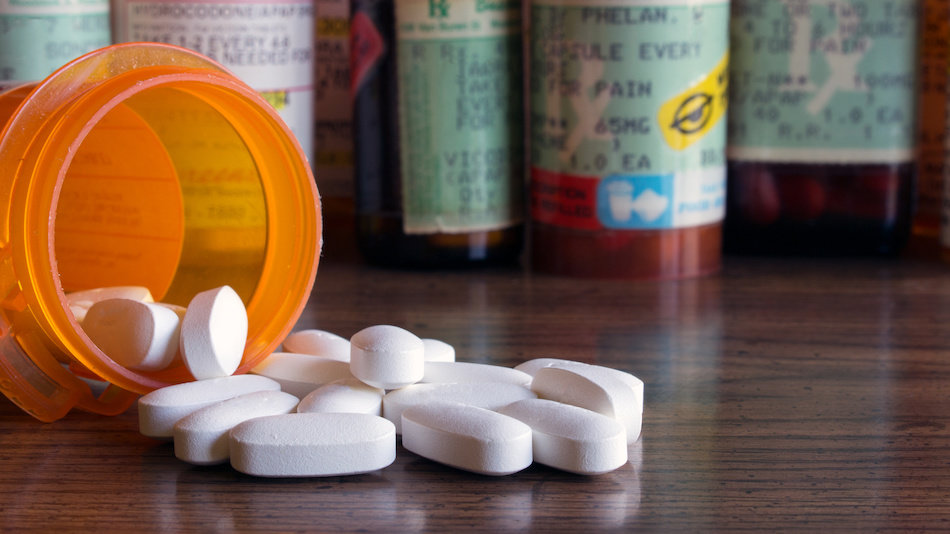
The problem: The vast majority of medications and adult toiletries (including makeup) are toxic. Unfortunately, many medicines and even makeup can resemble candy, which makes them very enticing for children around one or two years of age. Toiletries are often spread all around the bathroom on counters and shelves, so they're easier for us to access. But even if your bathroom is organized and well baby proofed, it's easy to accidentally leave something out when getting ready in a hurry.
Solutions:
- Keep the phone number for poison control on hand (1-800-222-1222).
- Do research and become very familiar with common bathroom products that that you may not realize qualify as a poison.
- Keep all of your medications in one location, so you'll be able to spot something that goes missing right away.
- Install baby proof latches on all of your cabinets and drawers.
- Use your medicine cabinet heavily, where your toddler can't reach.
Keep all toiletries and medications in their original bottles. These bottles usually have instructions about what to do in the event it is ingested inappropriately. Bottles also have product specs and ingredients, which can be helpful when making a toxicity diagnosis and treatment plan. Bring the bottle with you if you need to make a rush to the emergency room.
Bathtub
The problem: As already mentioned, the bathtub is a place where children unfortunately drown every year. A drowning can happen in just an inch or two of water! Aside from this very real threat, the bathtub can present problems in other ways as well.
Slips and falls are common in the bathtub, and children who play close the faucet are very likely to hit their head on it. Oddly enough, young children have been known to get their mouth stuck around the faucet. And children who turn on the water to refresh or fill the bathtub can easily burn themselves.
Solutions:
- Covers on the faucet prevent head bonks and also prevent your child from fitting their mouth around faucet.
- A non-slip mat for the bottom of tub prevents slips and falls.
- Toys with built-in temperature gauges make it easy to determine when water is too hot.
Teach your toddler not to stand in the bathtub. Sitting only! Turn down the temperature of your water heater to 120 degrees or lower, to prevent your child from getting scalded.
Most important, supervise your child while bathing until they're at least 6 years old. Older children can bathe alone, but remain close by in case something happens.
Baby's Room
Your baby's room should be a place where they can spend time alone safely. Although baby rooms are mostly filled with safe baby stuff, they can also contain personal hygiene products such as diaper rash cream, lotions, ect., and tools like thermometers or humidifiers. Sharp furniture corners can cause head injuries, just like in other rooms of the house.
It doesn't take much to ensure that your baby's room is a safe space, but you will need to spend some time looking at the room the way your child would. Sit on the floor and glance around. What do you see? What's within reach?
Furniture
The problem: Safety codes for baby furniture changes conctantly as time goes on. Used or hand-me-down furniture may not meet current safety standards, which could result in your child getting their head stuck, fingers pinched or some other kind of injury. Heavy, oversized pieces of furniture can be a falling hazard and sharp corners can result in injuries.
Solutions:
- Buy new major pieces of furniture (if possible).
- Read safety ratings or do research before purchasing the crib and other major pieces of furniture.
- Use earthquake straps or baby proofing straps to secure heavy items to the wall.
- Remove unnecessary, bulky furniture that could be a danger to the baby.
- Put bumpers on sharp corners to protect toddling little ones.
A nursery is a room where an adult can care for an infant. It has all the furniture and equipment required to care for the baby. As the baby gets older and develops the ability to move around independently, the nursery turns into a bedroom for play. As this happens, keep the room decor basic, free of excess furniture. Purchase small furniture your toddler can use safely while learning to do more things for themselves.
The Crib
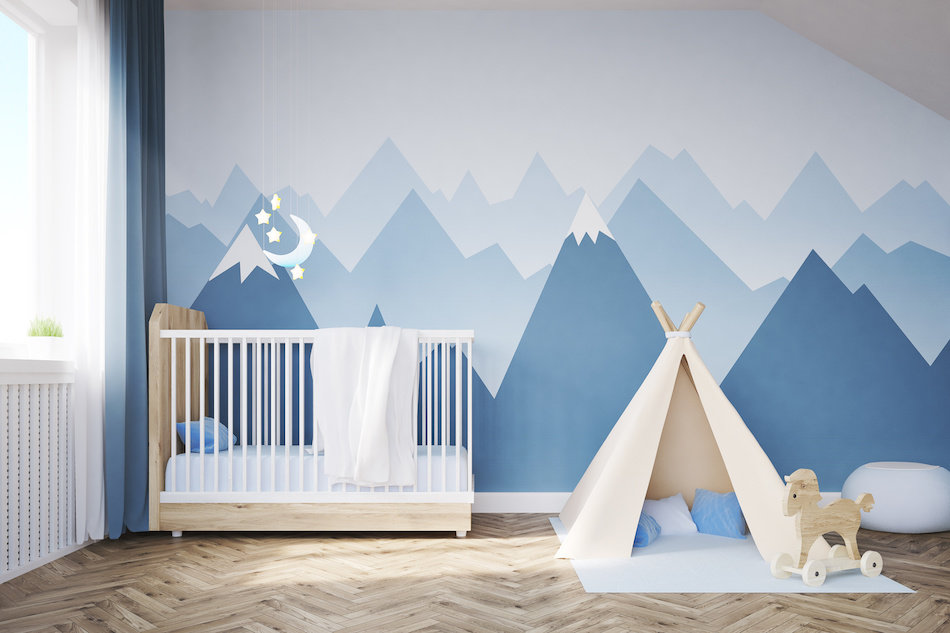
The problem: Older model cribs with drop-down sides are now banned because they are not safe for babies. And children who are older can get their head stuck between slats on some older cribs. Soft objects placed inside the crib can be a suffocation hazard for very young babies.
Finally, babies like to reach for mobiles. When they're old enough to grab onto them it's time to remove, they may drag down a ribbon or string that could lead to strangulation.
Solutions:
- Replace any crib with drop-down sides, or (if replacement is not possible) secure the sides, so they cannot be dropped down.
- Remove soft objects from the crib (including stuffed animals, pillows, blankets and bumpers) until at an appropriate age.
- Remove the mobile from the crib when your baby starts to sit up.
Measure the slats of your child's crib with a soda can. If a soda can fits between the slats, then the crib slats are too wide. If you must use a bumper, choose one that is mesh and breathable.
Changing Table
The problem: Babies can roll off of changing tables, leading to deadly falls or serious injuries. Parents who turn their back on their baby even for a moment could fail to protect their child from this kind of fall. While on the table, babies can reach for things that they should not have, such as baby powder, topical creams and other hygiene products as well as Q-Tips and other small objects.
Solutions:
- Use the safety straps that came with your baby's changing table.
- Set up the area so you never have to turn your back on your child during changing.
- Keep things out of your baby's reach.
- Reserve a specific toy or object that they can have to keep their attention when on the table.
Installing small shelves and drawers near the changing table makes it possible for you to reach everything you need while always keeping 1 hand on baby.
Laundry Room
The problem: The laundry room contains a lot of toxic laundry products. If toddlers can gain access the cleaning products, they could accidentally poison themselves. The washer and dryer contain dials and doors that fascinate little ones. Toddlers can open doors, pinch their fingers, and even climb inside.
Solutions:
- Lock the laundry room or use a baby gate.
- Put cleaning products up high or use a safety latch to keep the cabinets closed.
- Never reuse containers that once held cleaning products to hold toys, food or other objects.
Garage
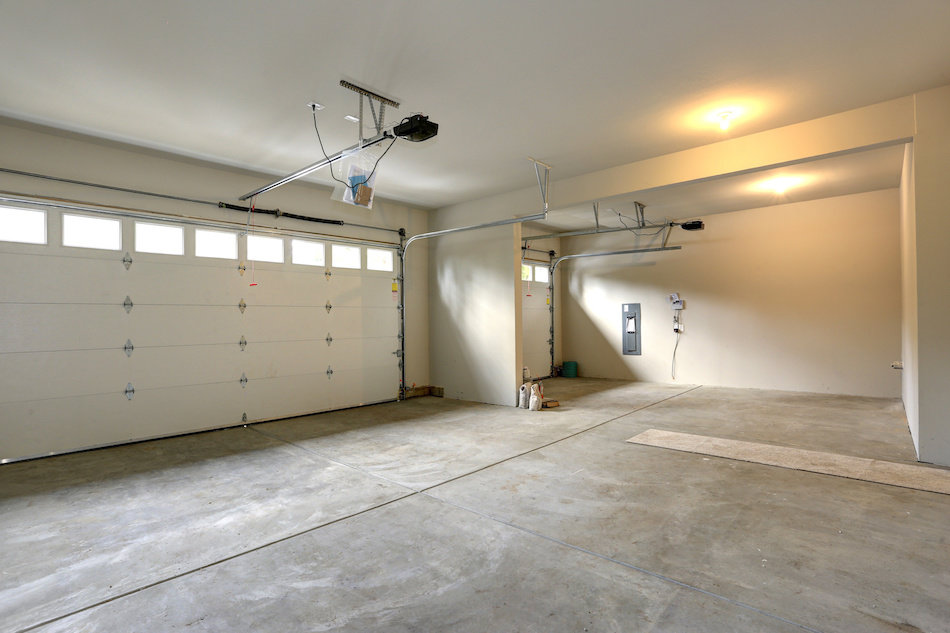
The problem: There's very little about the garage that isn't a serious safety hazard for a toddler. Most garages are full of chemicals, power tools, automotive accessories, moving vehicles, bicycles, trash and so much more. Toddlers with easy access to the garage can:
- Ingest chemicals.
- Pull large things down on top op of themselves.
- Be hit by a slowly moving vehicle.
- Slip on a spill.
- Make a mess.
- Cut themselves on power tools.
- Touch something like fertilizer that could cause skin irritation or even a burn.
Solutions:
Unless your garage has recently been converted into a safe play space, your toddler should not be allowed to enter the garage. The best way to baby proof the garage is to restrict access.
Use a baby gate, keep the door locked, keep the lights off (except when it's in use), and use stern words to express the dangers of the garage. When you're in the garage together, show your child the things in the garage that can lead to injuries.
Keep garage clickers out of reach, or place a small locked cabinet on the way into the garage where you can keep clickers, flashlights and other things you might need to access easily.
Outside Areas and Backyard
The backyard and outside areas should be a place of delight for your child, where your baby or toddler can breathe outside air, hear outside sounds, be loud and play. Children need to be supervised while outside until they reach a certain age, but even with supervision, some baby proofing is still necessary.
Water Features
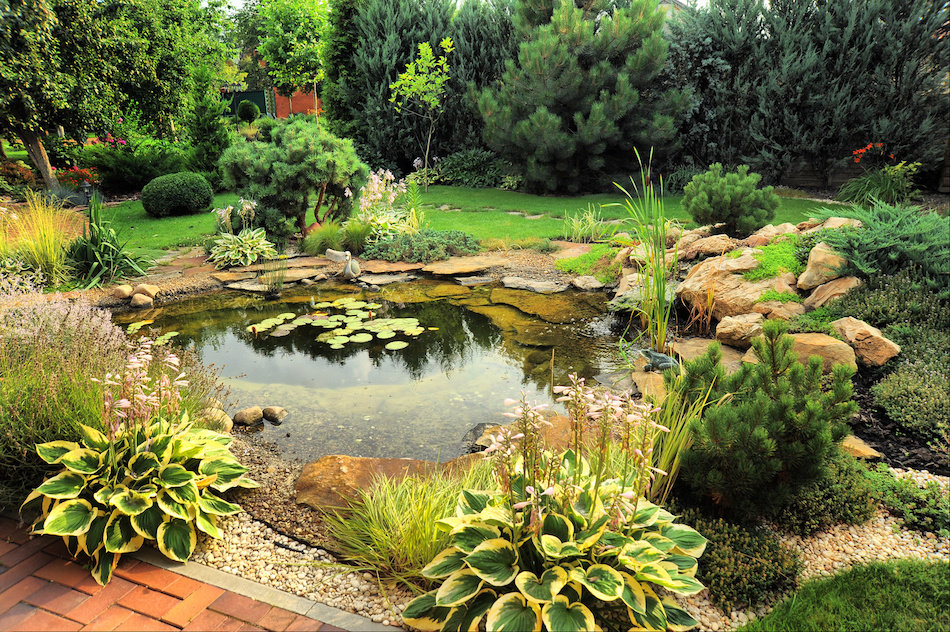
The problem: All backyard water features (pools, hot tubs, Koi ponds, creeks, rivers, ponds, lakes, etc.) present a drowning danger for little ones. It takes children very little time to let themselves into the backyard, unnoticed, and fall into a pool. Children who spend a lot of time in the pool and who are comfortable with water may be more confident and likely to enter the water alone than other children. Mosquitoes may also pose a threat in areas with standing water.
Solutions:
- Gates and fences prevent children from accessing the pool, even if they can get outside.
- Alarm and alert systems come in different varieties to notify parents when a gate opens, when the back door opens or even when a person enters the water.
- Hard covers prevent children from entering the water and can also be used to close up the pool when the homeowner leaves town.
- Taking measures to prevent mosquitoes from entering and laying eggs in your backyard.
If your child spends a lot of time in the water, start your child on swim lessons and start discussing the dangers early on. Even babies can take special swim lessons for their age, and can be taught to float on their backs. Swim lessons can save lives.
Kid-Free Zones
The problem: There are some parts of the yard where toddlers and babies just shouldn't go. This might be the grilling spot, the large outdoor air conditioner condenser or the storage area for lawn care and other homeowner tools. In these areas, children can get burns, can ingest poisons, can damage expensive equipment and can suffer other injuries.
Solutions:
Most of these kid-free zones can be protected by a fence. In some cases, the fence can be a portable baby gate, and in other cases, the fence can be an actual permanent fence. As a homeowner, you'll have to decide which solution aligns with your future goals and aesthetic preferences.
Although most baby gate fences are not very attractive, they are easy to remove when they're no longer needed. Permanent fences cost more to put in and more to pull out. In fact, a 4 foot high chain link fence can cost anywhere from $7 to $12 per linear foot to install.
Safety First!
Before baby proofing your home, get down to your child's point view. See how an infant or toddler sees your space. Most of all, personalize your baby proofing. As your child grows, you'll start to get a sense of your child's personality.
It should be easy for you to predict what your child is likely to try, and where your child is likely to find trouble. All babies are different. Some babies just have to stick their fingers in every hole and push every button, others have to pull and climb on everything they see. Adjust your baby proofing efforts to your space at home, and your child's interests.
Spend your time teaching good decision making skills and setting clear boundaries. Model good behavior. Use words from an early age to explain why something is dangerous and how to stay safe. Use repetition to drive points home. Having the tools you need to protect your child will relieve some anxiety and may save your child's life.
Finally, don't forget that baby proofing can provide peace of mind, but nothing should replace adult supervision. Watch your baby carefully.
